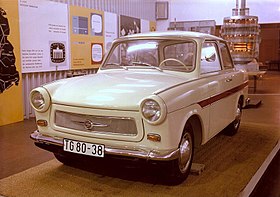Trabant 601
| Trabant 601 | |
|---|---|

Trabant 601 in 1963
|
|
| Overview | |
| Manufacturer | VEB Sachsenring |
| Also called | Trabbi |
| Production | 1963–1990 |
| Model years | 1964–1990 |
| Assembly | Zwickau, Germany |
| Body and chassis | |
| Class | C-segment |
| Body style | 2-door saloon (Limousine) 2-door estate (Universal) Doorless ATV (Tramp) |
| Layout | FF |
| Platform | Trabant P601 |
| Related | Wartburg 353 |
| Powertrain | |
| Engine | P 6x (Otto, 594,5 cm3, 19,1 kW) |
| Transmission | 4-speed manual |
| Propulsion | Tyres |
| Dimensions | |
| Wheelbase | 2020 mm |
| Length | 3555 mm |
| Width | 1505 mm |
| Height | 1440 mm |
| Kerb weight | 615 kg |
| Chronology | |
| Predecessor | Trabant P60 |
| Successor | Trabant 1.1 |
The Trabant 601 (or Trabant P601 series) was a Trabant model produced by VEB Sachsenring in Zwickau, Sachsen. It was the third generation of the model, built for the longest production time, from 1963 to 1990. As a result, it is the best-known Trabant model and often referred to simply as "the Trabant" or "the Trabi". During this long production run, 2,818,547 Trabant 601s were produced overall and it was the most common vehicle in former East Germany.
With hindsight it can be considered East Germany's response to West Germany's 'Peoples Car', the VW Beetle. Its purpose was to provide a cheap but still reliable car that was very affordable and also easy to repair and maintain. Still, it was at the time of its release rather modern in many ways, with front wheel drive, a low maintenance engine, unitary construction, composite bodywork and independent suspension all around. The main letdown was the pre-war DKW based engine that was competitive when launched, but from the late 1950s into the 1960s, small economy cars in western countries that used two-stroke engines, were replaced with cleaner and more efficient four-stroke engines, as employed from the start in the Volkswagen Beetle. Two-stroke engines of this sort, with crankcase scavenging and lubricating oil provided during fuel intake, burn their lubricating oil by design and produce smoky tailpipe emissions. However, two-stroke engines were also to be found in cars like the Western German Auto Union 1000 that ended production in 1963, and the Swedish Saab 96 that changed to four-stroke in 1967. The lack of development funds in East Germany forced the continued use of a two-stroke engine in the Trabant, thus causing this vehicle to become obsolescent in the 1960s and extremely obsolete by the 1980s.
The Trabant 601 was a modern automobile when introduced in 1963, with 150 Pre-Production examples. The body was modified from the previous P50/P60 variants of the Trabant, with a heavy emphasis on the front and roof area. The back of the car was also modified with different taillights and a higher trunk loading height as compared to previous models. Overall the design was praised, particularly on the then modern double trapezoid design. Originally production was planned to run from 1967 to 1971, but in practice continued until 1990.The original engine was only 17 kW (23 hp), but in 1969 a new version was offered with a 19.1 kW (26 hp) engine. In 1974 a Needle roller bearing was added to the connecting rod, allowing for a 50/1 lubricant to be used. Through the addition of a 2-stage carburetor in 1984, the fuel consumption was brought down by 1/100 l/km. With these additions, the top speed measured was measured to be 107 km/h. Even with these improvements the fuel consumption could still rise rapidly with extended acceleration or when towing a trailer. The P601 also had a overrunning clutch when running in 4th gear.
...
Wikipedia
